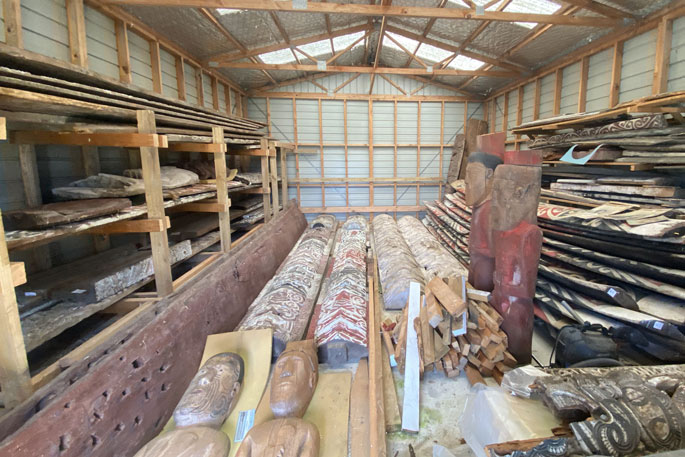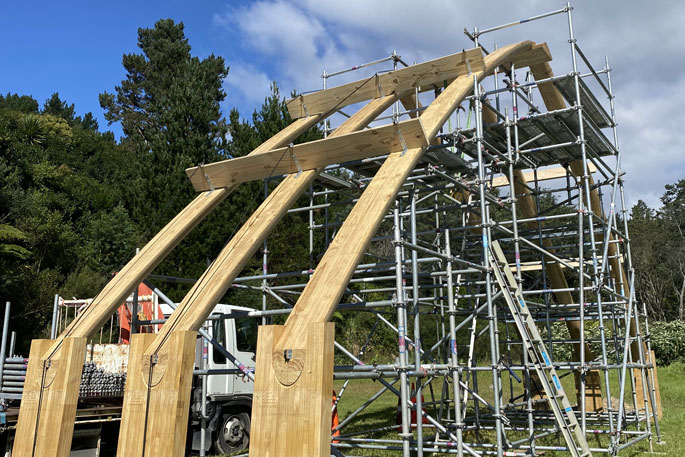Internationally acclaimed architect and researcher Professor Anthony Hoete and his team will this month conduct a full-scale seismic test on ancient Māori construction techniques they aim to use to rebuild a historic Bay of Plenty wharenui.
The wharenui near Opōtiki has not stood since the Napier earthquake, and a team from the University of Auckland, led by Hoete, will incorporate endangered construction knowledge called mīmiro to build a full-scale prototype timber structure.
This week team will test the seismic resilience of the prototype thanks to the support of Toka Tū Ake EQC.
Hoete and Māori architectonic researcher Dr. Jeremy Treadwell have designed and built the timber portals by using interlocking compression joints, instead of bolting parts together. At the same time, ropes will pull the structure to the ground like a tent.
'We are pretty confident in our designs, but the proof will be in the real-life full-scale testing,” explains Hoete.
In the testing stage, his team will collaborate with the School of Engineering to pull the vertical portals sideways using a winch off Professor Jason Ingham's jeep. This will test the horizontal strength while the vertical strength is tested using water weights.
The project was awarded funding from Toka Tū Ake EQC (Earthquake Commission) to enhance the seismic resilience of the new wharenui and its community.
'Toka Tū Ake EQC wants to create more resilient communities through the design and construction of stronger buildings, so Professor Hoete's work aligns well with our goal to improve Aotearoa New Zealand's resilience to natural hazards,” says Toka Tū Ake EQC Manager Research Natalie Balfour.
'Investing in Māori researchers and matauranga Maōri has been a key focus of this year's biennial grants, so we are proud to be able to support this amazing project,” says Balfour.

Aside from Toka Tū Ake EQC funding, the research is also supported by QuakeCoRE, the Centre of Research Excellence for seismic resilience, and the Endangered Wooden Architecture Programme at Oxford Brookes University.
Hoete says that the origins of mīmiro can be traced back to the ships and strong sail lashing his ancestors used to travel across the Pacific.
'They had a deep knowledge of building and creating strength and tension in structures, so we want to recreate those techniques that have been lost and use them to give our wharenui greater seismic resilience,” says Hoete, who states that there is only one known whare remaining in New Zealand built with mīmiro techniques, which is a Whakāta in the Okains Bay Museum on Banks Peninsula.
The team works closely with Ngāti lra o Waioweka, who built the original Tānewhirinaki wharenui near Opōtiki during the 1860 New Zealand Wars, only to witness its destruction in the 7.8 magnitude earthquake in 1931.
The most important carvings representing the iwi's ancestors were saved from the wreckage and remarkably stored in a shed at the marae for nine decades.
During a wānanga held at Waioweka Marae last year, Hoete's team attached the carvings to a scaffolded framework before LiDAR scanned the framework with lasers to create an accurate record of the physical dimensions of each carving. This information could then inform the reconstruction of Tānewhirinaki.
Hoete says that the original timber had deteriorated over 90 years and would not be able to carry the loading of a new wharenui.
'So instead, we will design a new structure that will act like an outer whare to which we will sensitively attach the original carvings to the inside of this new structure.”
Hoete says that the local hapū, Ngāti Ira, is integral to the project. Furthermore, through outreach events with local schools and the community, Hoete feels the learnings from this project has the power to transform communities.



0 comments
Leave a Comment
You must be logged in to make a comment.